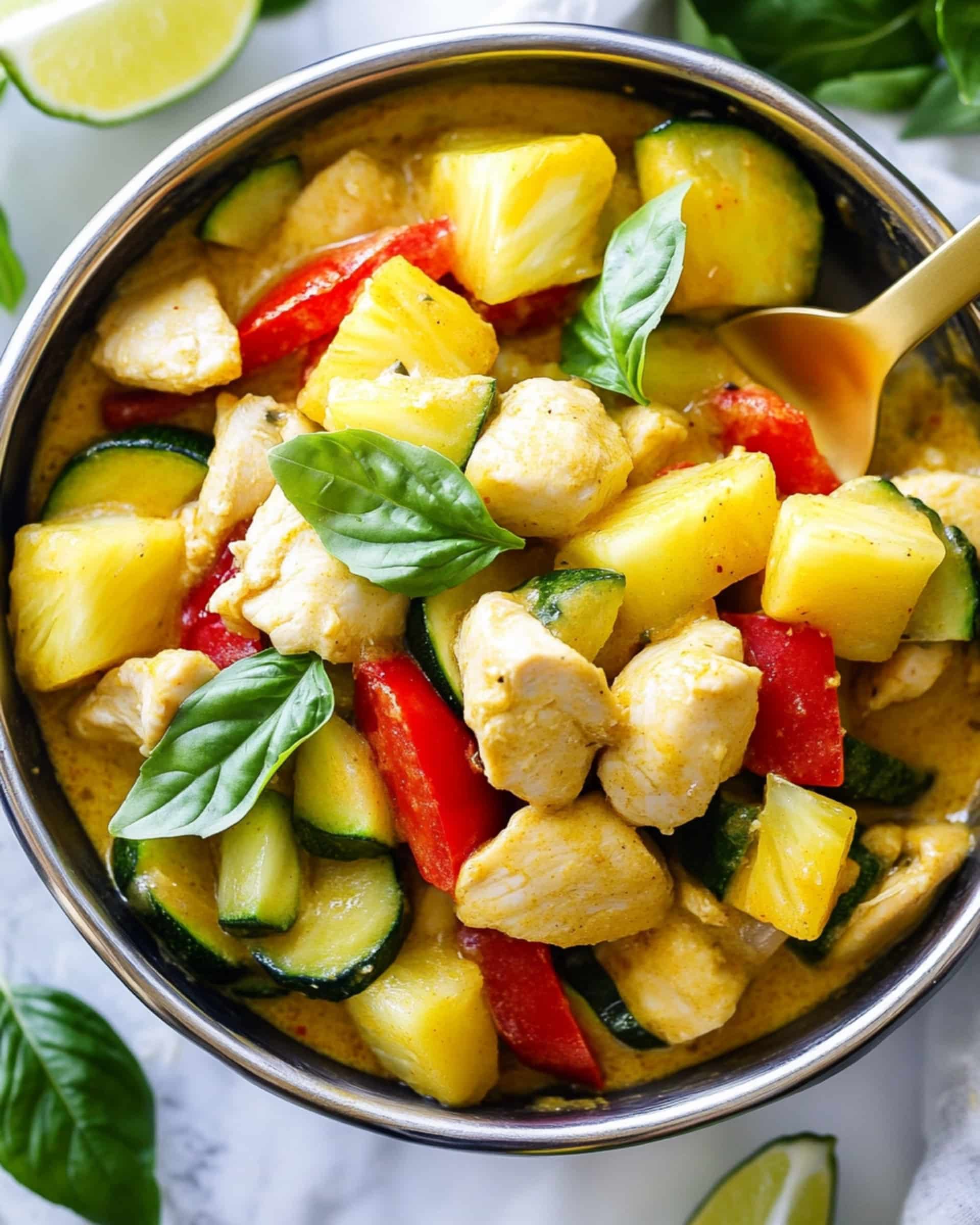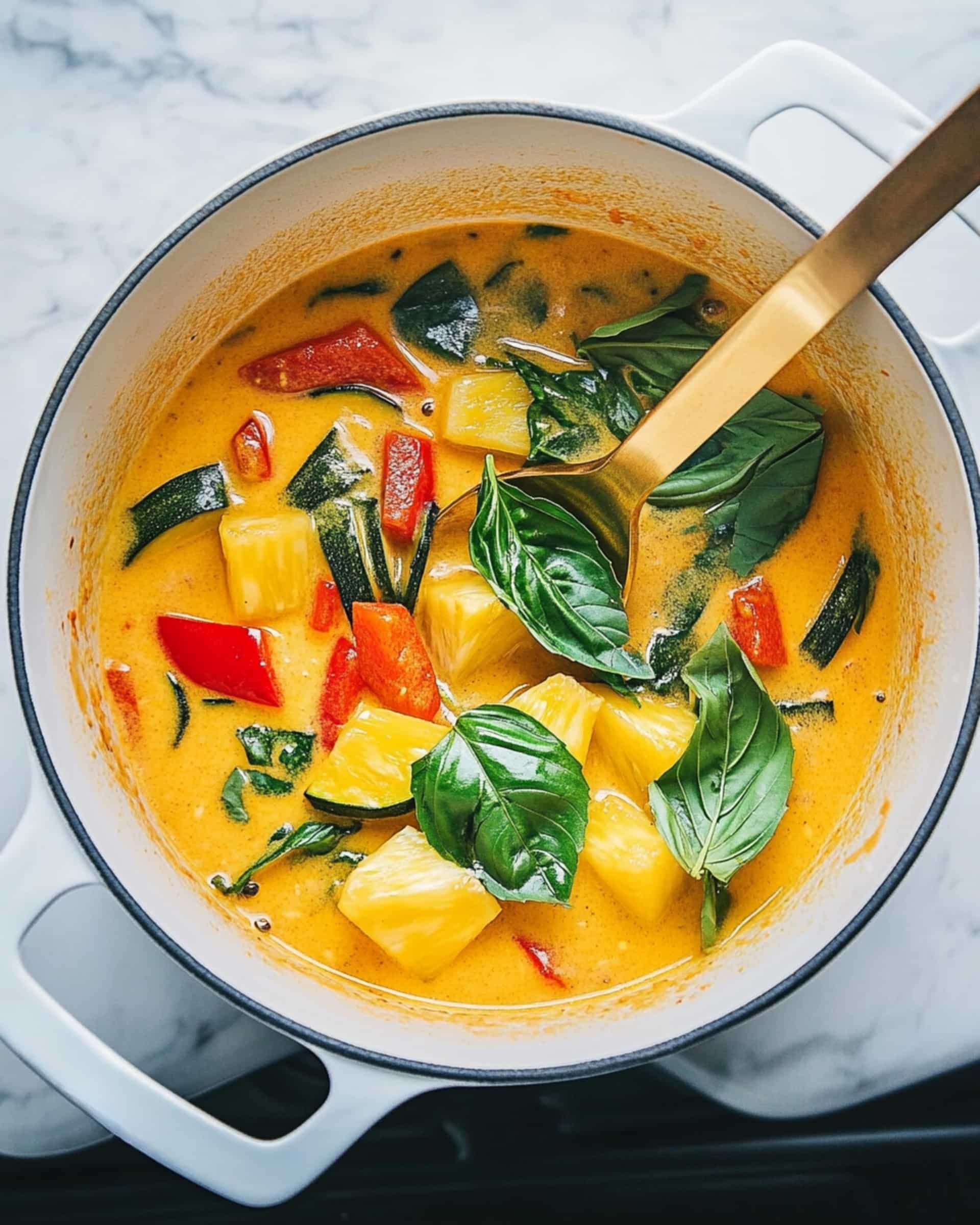This vibrant Thai Pineapple Curry brings together the perfect balance of sweet, savory, and spicy flavors in just 20 minutes. The juicy pineapple chunks meld beautifully with creamy coconut milk and aromatic red curry paste, creating a restaurant-quality dish that’s surprisingly simple to make at home. Whether you’re cooking for family or friends, this curry delivers tropical paradise flavors straight to your dinner table with minimal effort.
Why You’ll Love This Recipe
- Quick Weeknight Wonder: From prep to table in just 20 minutes, making it perfect for those busy evenings when you want something delicious without spending hours in the kitchen.
- Flavor Explosion: The combination of sweet pineapple, rich coconut milk, and aromatic curry paste creates layers of flavor that taste like they’ve been simmering all day.
- Versatile: Works beautifully with chicken, shrimp, tofu, or just vegetables—adapt it to whatever you have on hand or your dietary preferences.
- Impressive Yet Simple: Guests will think you’ve been cooking all day, but you’ll know it took less effort than ordering takeout.
Ingredients You’ll Need
- Red curry paste: The flavor foundation of this dish—provides that authentic Thai taste with complex spice notes without requiring dozens of individual spices.
- Coconut milk: Use full-fat for the most luxurious, creamy texture that balances the spice beautifully.
- Brown sugar: Adds a subtle caramel sweetness that perfectly complements the pineapple and helps balance the heat from the curry paste.
- Fish sauce: Don’t be intimidated by the smell! This ingredient provides that distinctive umami depth that makes Thai food so addictive.
- Chicken: Thinly sliced for quick cooking and maximum flavor absorption. The protein canvas for our curry masterpiece.
- Pineapple: Fresh is best—providing juicy sweetness and slight tanginess that defines this curry. The star of the show!
- Tomatoes: Adds lovely acidity and freshness that cuts through the richness of the coconut milk.
- Zucchini: Provides a tender-crisp texture and absorbs all the amazing curry flavors while adding nutritional value.
- Red bell peppers: Brings vibrant color, sweet crunch, and vitamin C to the party.
- Thai basil: The aromatic finish that elevates the entire dish with its distinctive anise-like flavor. Don’t even think about skipping this!
- Lime: That final bright note that makes all the flavors pop and brings the dish into perfect balance.
Variations
Protein Options
- Seafood Sensation: Swap chicken for shrimp or chunks of firm white fish for a coastal twist.
- Vegetarian Delight: Use crispy tofu or double the vegetables for a meat-free version that’s just as satisfying.
- Mix and Match: Combine half chicken and half shrimp for the best of both worlds.
Vegetable Variations
- Green Machine: Use snow peas, green beans, or asparagus instead of zucchini for seasonal alternatives.
- Extra Veggie Power: Add mushrooms, baby corn, or bamboo shoots for additional texture and flavor.
- Heat Seeker’s Version: Add thinly sliced Thai chilies or a dollop of chili paste if you like it fiery hot.
Dietary Adaptations
- Vegan Friendly: Use vegan fish sauce (made from seaweed) and tofu or just vegetables.
- Sugar-Free Option: Replace brown sugar with a monk fruit sweetener or just rely on the natural sweetness of the pineapple.
How to Make Thai Pineapple Curry
Step 1: Create Your Curry Base
In a medium pot over high heat, combine the red curry paste with about three-quarters of the coconut milk. Stir continuously until you see the mixture bubble and a creamy, fragrant sauce forms (about 1-2 minutes). This crucial step releases the aromatic oils in the curry paste.
Step 2: Develop The Flavors
Add brown sugar and fish sauce to the bubbling curry base, stirring to incorporate. Let this mixture simmer for about a minute, allowing the sugar to dissolve and the fish sauce to begin working its magic.
Step 3: Cook The Protein
Add your thinly sliced chicken and a quarter cup of water or broth to the pot. Cook for 4-5 minutes, stirring occasionally until the chicken is tender and cooked through. The thin slices will cook quickly while absorbing the curry flavors.
Step 4: Add Fruits & Vegetables
Toss in the pineapple chunks, diced tomatoes, zucchini pieces, and red bell pepper. Cover the pot and let everything cook together for 2-3 minutes, just until the vegetables slightly soften but still maintain some crispness.
Step 5: Balance & Finish
Pour in the remaining coconut milk and adjust the flavors to your preference. This is your chance to make it truly yours—add more fish sauce for saltiness, sugar for sweetness, or even extra curry paste for heat. Squeeze in some lime juice to brighten everything up.
Step 6: Add The Fresh Herbs
Turn off the heat and fold in the Thai basil leaves. The residual heat will release their aromatic oils without destroying the delicate flavor. Let the curry sit for a couple of minutes to allow the flavors to meld together.
Pro Tips for Making the Recipe
- Prep Before You Start: Have all ingredients cut and measured before heating the pan—this curry comes together quickly!
- Balance Is Key: Thai cuisine is all about balancing sweet, salty, sour, and spicy. Taste as you go and adjust accordingly.
- Don’t Overcook the Vegetables: They should retain some crispness for textural contrast against the tender chicken and soft pineapple.
- The Coconut Trick: Using most of the coconut milk at the beginning helps create that beautiful red oil that indicates an authentic curry.
- Layer Your Flavors: Adding ingredients in stages allows each component to contribute its unique character to the final dish.
How to Serve

Perfect Pairings
Serve this vibrant curry over a bed of fragrant jasmine rice that will soak up all those incredible juices. For a lower-carb option, cauliflower rice works beautifully too.
Garnishes
A scattering of fresh Thai basil leaves, a few lime wedges for squeezing, and if you’re feeling fancy, some thinly sliced red chili for those who want extra heat.
Complete the Meal
Pair with a simple cucumber salad dressed with rice vinegar and a touch of sugar for a refreshing counterpoint to the rich curry.
Make Ahead and Storage
Storing Leftovers
This curry actually improves with time as the flavors continue to develop. Store in an airtight container in the refrigerator for up to 3 days. The coconut milk may separate slightly when cold—this is completely normal.
Freezing
You can freeze this curry for up to 2 months in a freezer-safe container. The texture of the vegetables may change slightly upon thawing, but the flavor remains delicious.
Reheating
Gently warm in a saucepan over medium-low heat until just heated through. Add a splash of coconut milk if the sauce has thickened too much during storage. Avoid boiling as this can make the chicken tough and break the delicate sauce emulsion.
FAQs
Can I use green curry paste instead of red?
Absolutely! Green curry paste will give a different but equally delicious flavor profile—often more herbal and slightly less spicy. The pineapple pairs wonderfully with either version, so feel free to use whichever you prefer or have on hand.
I can’t find Thai basil anywhere. What should I substitute?
Regular sweet basil will work in a pinch. To mimic that distinctive Thai basil flavor, add a small pinch of ground star anise or fennel seeds to regular basil. The anise notes are what make Thai basil special, and this trick helps approximate that unique flavor.
My curry seems too watery. How can I thicken it?
If your curry ends up thinner than you’d like, simply simmer it uncovered for a few extra minutes to reduce the liquid. Alternatively, you can mix a teaspoon of cornstarch with a tablespoon of cold water and stir this slurry into the simmering curry. Remember that the curry will also thicken slightly as it cools.
Is this curry naturally gluten-free?
Most ingredients in this curry are naturally gluten-free, but always check your curry paste and fish sauce brands as some may contain gluten. With gluten-free versions of these ingredients, the entire dish is suitable for those avoiding gluten.
Final Thoughts
This Thai Pineapple Curry is the perfect example of how a few quality ingredients can transform into something truly extraordinary with minimal effort. The sweet-savory balance and aromatic depth make it taste like you’ve spent hours in the kitchen, when in reality it comes together in just 20 minutes. Whether you’re cooking for a special someone or treating yourself after a long day, this curry delivers maximum flavor with minimum fuss. Give your taste buds a tropical vacation without leaving your kitchen!
Print
Thai Pineapple Curry Recipe
- Prep Time: 10 minutes
- Cook Time: 10 minutes
- Total Time: 20 minutes
- Yield: 4 servings 1x
- Category: Main-course
- Method: Stovetop
- Cuisine: Thai
- Diet: Gluten Free
Description
This vibrant Thai Pineapple Curry is a flavorful main course featuring tender chicken (or tofu/shrimp), fresh pineapple, and assorted vegetables simmered in a creamy coconut red curry sauce. Balanced with sweet, savory, and tangy notes, it’s garnished with aromatic Thai basil and lime, making it a perfect weeknight dinner served over jasmine rice.
Ingredients
Main Ingredients
- 1/4 cup red curry paste (store-bought or homemade)
- 1 can (13.5 oz) coconut milk (full fat recommended)
- 1–2 tablespoons brown sugar (adjust as needed, or sub coconut sugar, honey, or alternative sugar)
- 1–2 tablespoons fish sauce (or vegan fish sauce, adjust as needed)
- 1 lb chicken, cut into thin bite-sized slices (or substitute crispy tofu or shrimp)
- 1/4 cup water or broth
- 1 cup fresh pineapple, cut into bite-sized pieces (or use frozen, or canned – drained & rinsed)
- 1 cup tomatoes, cut into bite-sized pieces
- 1/2 cup zucchini, cut into bite-sized pieces (or substitute snow peas, green beans, or asparagus)
- 1/2 cup red bell peppers, diced
- 1/2 cup Thai basil (or substitute regular basil)
- A squeeze of lime to taste
- Optional: 5-6 Kaffir lime leaves (add to the simmering sauce)
To Serve
- Jasmine rice
- More Thai basil for garnish
- Lime wedges
Instructions
- Cook Curry Paste & Coconut Milk: Add the red curry paste and 3/4 of the can of coconut milk to a medium pot over high heat. Stir together until a creamy sauce forms, about 1-2 minutes, or until bubbles appear on the sauce surface.
- Add Seasonings: Mix in the brown sugar and fish sauce, stirring to combine. Simmer for 1 minute to blend the flavors.
- Cook Protein: Add chicken slices and water (or broth) to the pot. Cook for 4-5 more minutes, stirring occasionally, until the chicken is tender. If substituting tofu, shrimp, or vegetables only, cook for just 2–3 minutes.
- Add Pineapple & Vegetables: Incorporate the pineapple, tomatoes, zucchini, and red bell peppers. Cover and cook until vegetables are slightly softened, about 2–3 minutes. Add kaffir lime leaves at this stage if using.
- Finish with Coconut Milk & Adjust: Pour in the remaining coconut milk. Taste and adjust flavors by adding more fish sauce, salt, brown sugar, or extra curry paste to your preferences. Add a squeeze of lime if desired. Note that serving over rice will mellow the flavors.
- Add Basil & Serve: Turn off the heat and stir in Thai basil. Allow the curry to cool slightly. Serve hot over jasmine rice and top with additional fresh basil and lime wedges. Enjoy!
Notes
- Fresh pineapple is recommended for best flavor, but frozen or canned (well-drained) can be used. Adjust sugar and fish sauce if using canned due to higher sugar and acidity.
- Customize protein: Use chicken, tofu, shrimp, or make it all vegetable-based. For tofu or shrimp, shorten the cooking time by two-thirds compared to chicken.
- Red curry paste spiciness varies by brand; start conservatively and add more as needed.
- Thai basil gives authentic flavor, but sweet basil with a pinch of dried anise works in a pinch.
- Serve with jasmine rice to round out the meal and mellow the sauce.
Nutrition
- Serving Size: 1/4 of recipe
- Calories: 380
- Sugar: 16g
- Sodium: 910mg
- Fat: 18g
- Saturated Fat: 13g
- Unsaturated Fat: 4g
- Trans Fat: 0g
- Carbohydrates: 31g
- Fiber: 3g
- Protein: 26g
- Cholesterol: 65mg



